|
Ukrainian Greek Catholic
Church
Click to view a photo
gallery for more images of the interior and exterior architecture
of the church.
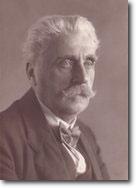 |
|
The church was designed in Ukrainian baroque
style by the architect Jan
Zubrzycki – a native son of Tluste. The priest
at the time, Teodozij Kurpiak, paid for the plans to be
drawn up, and the first stone was laid by Vasyl Badlyuk.
As the architectural drawing (at right) reveals, Zubrzycki’s
original design was more ornate than the construction
that was ultimately realised. |
|
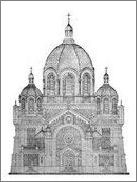 |
The church has a very deep foundation. When it was excavated,
bones were uncovered, presumably from the cemetery of another
even older church that had once stood in its place. The skeletons
of the individuals uncovered, said to have been very tall,
were reburied in the cemetery (Pawlyk, pers. comm.).
| Construction had to be stopped during the
difficult years of the First World War and in the postwar
period, and was resumed only in the mid-1920s. |
|
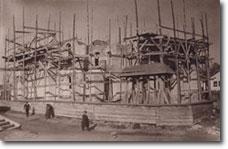 |
|
As can be seen in this photo, dated 1927,
the construction had reached only about 10 m by that time
and was nowhere near to being finished. |
Apparently, the reasons for the slow progress concerned more
than just lack of funds for construction. The townspeople
objected to the fact that it was destined to become an orthodox
church, preferring instead that it be Greek Catholic. Their
will ultimately prevailed.
Since the old wooden church had already been demolished to
make way for the new construction, for more than a decade
people had to attend services in a provisional wooden chapel,
also mentioned in the Greek Catholic schematism for 1912.
It was so small that the parishioners overflowed into the
churchyard even during the wintertime.
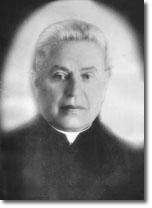 |
|
Anton
Navolskyy arrived in Tluste around 1930 to succeed
Teodozij Kurpiak as priest, and he undertook to realise
the completion of the church. After the death of Jan
Zubrzycki in 1935, Mr. Stanislavskyy supervised the
construction. Minutes from the Greek Catholic church,
kept from 1913 to 1946 -- now on file at the museum
-- record details of the building process, including
payments for basic materials. One can observe, for example,
that the town’s dealer in construction materials,
Hersch Spitzer, donated wood free of charge; and that
parishioners paid for other materials and services through
a barter system (for example, eggs in exchange for certain
work).
|
| |
|
|
| The exterior was mostly complete by around
1939 but the interior, including the cupola, was still
not yet decorated. It was said that the authorities in
Ternopil refused permission to decorate the church. Presumably
this was linked to the lingering dispute over its denomination.
The head of the local administration, Vasyl Tracz, went
ahead regardless and the interior work was finished around
1942 – but not before Tracz was reprimanded for
his actions. |
|
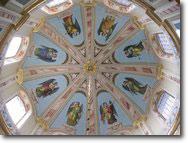 |
Work was still underway to put the finishing touches on the
church when the Germans invaded the region in July 1941. That
month, a huge explosion of an arms-laden transport train at
the station of Tluste damaged the metal frame windows of the
newly completed church, but otherwise it remained structurally
intact.
This would not be the only threat to its existence, however.
As Pawlyk reports in the History of Tovste, following
the death of Andriy Sheptytskyy, Archbishop of the Ukrainian
Greek Catholic church, on 1 November 1944, the KGB with the
consent of Stalin began to liquidate the Greek Catholic church
in Ukraine. Many Catholic priests were arrested and imprisoned,
and were sent to concentration camps in Siberia.
According to the resolutions of party bodies in Lviv on 8-10
March 1946, decisions of the Union of Brest were cancelled
and the Greek Catholic Church became subordinate to the Russian
Orthodox Church. The Greek Catholic church of Tovste continued
to function secretly through underground activities. Priest
Anton Navolskyy was allowed to conduct mass for some time,
but in the 1950s he was relieved of his duties.
* * * * *
As shown in this architectural sketch
from 1994, the height of the church to the top of the
cupola is about 28.5m, and the entire structure, including
the cross, stands 32.7m high.
A modern belltower (pictured below) was built near
the church that year to replace a temporary wooden structure.
The new tower, constructed of plain grey brick, houses
a single, large bell procured around 1990. |
|
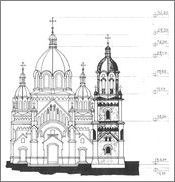
|
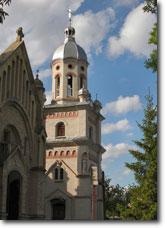 |
|
The original bells for the church were hidden
during the Second World War, to keep them from being looted
by the Nazis. They were thought to have been hidden somewhere
on the church grounds, but the persons who hid them since
died. The secret of the bells’ location went with
them to their grave, and they were never found. |
| Final note: At the time of writing, in Spring
2006, artisans from Lviv had almost completed an extensive
redecoration of the interior artwork, a project lasting
more than two years. The result of their meticulous and
skillful artistry - especially visible in the cupola -
is breathtaking.. |
|
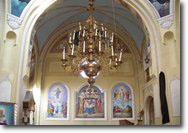 |
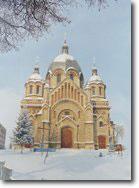 |
|
While the interior of the church has now
been completely restored to its former glory – and
perhaps surpassing it – there is reason for concern
about the integrity of the exterior of the century-old
structure. Portions of the massive stonework are decaying
and resources are not available for undertaking proper
repairs. Instead, the defects have been plastered over
with makeshift cement patches. Funding is required for
the exterior restoration work that needs to be done by
skilled artisans in stone masonry. |
If you would like to contribute to the further restoration
of the church, please use the Feedback
page to indicate your potential support. 
|

